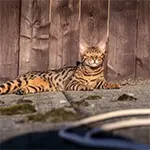
The toyger breed was created thanks to breeders in California who decided to cross Bengali cats with cats whose coat pattern was a more marked and defined tabby or mackerel, that is, with the typical stripes of tigers.
Summary
Origin and History
The Toyger breed was developed in the late 1980s by Judy Sugden, with the goal of creating a domestic cat with a coat pattern that mimics the iconic stripes of a wild tiger. Sugden noticed the two spots of tabby markings on the temple of her cat, Millwood Sharp Shooter, which resembled the circular patterns seen in the wild tiger’s head. This observation sparked the idea to breed a cat that could serve as a reminder of the conservation needs of its larger cousins. The development of the Toyger involved selective breeding of domestic shorthaired tabbies that exhibited desirable traits, such as bold stripes and a muscular build, eventually leading to the distinctive Toyger breed we see today.
Physical Characteristics
Toygers are medium-sized cats with a muscular and athletic build that evokes the power and grace of a wild tiger. Their most striking feature is their dense, soft coat, which is mackerel tabby patterned with bold, black stripes against a background of rich orange or gold. The breed’s coat is designed to mimic the pattern of a tiger’s, including the circular markings on the face and the “belly buttons” – a trait unique to tigers and Toygers. They have high cheekbones, small ears, and large, round eyes that contribute to their wild appearance.
Personality and Temperament
Despite their wild looks, Toygers are known for their gentle, playful, and friendly disposition. They are highly social and enjoy the company of humans and other pets alike, making them excellent companions for families and individuals. Toygers are intelligent and curious, often showing a keen interest in their surroundings and enjoying interactive play. They have a moderate energy level, enjoying bursts of playtime as well as moments of relaxation and cuddling.
Care and Health
Toygers are generally healthy, but as with any breed, they can be prone to certain genetic health issues. Regular veterinary check-ups, vaccinations, and preventive health measures are important to keep them in good health. Their coat requires minimal grooming, though regular brushing can help minimize shedding and keep their coat looking its best. Providing a balanced diet, regular exercise, and mental stimulation are key to maintaining their well-being.
Living with a Toyger
Living with a Toyger offers a unique experience to have a “wild” cat with the temperament of a loving domestic pet. They adapt well to indoor living but benefit from having space to play and explore. Enrichment through toys, climbing structures, and interactive play can help keep them mentally stimulated and physically fit. Toygers get along well with children and other pets, making them a wonderful addition to a variety of homes. For those fascinated by the beauty of wild tigers and looking for a devoted and engaging feline companion, the Toyger is an exceptional choice.
Latest on CatOlympus
Effects Of Music On Cats: Do Cats Enjoy Music?
For many cat owners, music is a regular part of daily life. We play it while cooking, cleaning, relaxing, or...
Myths And Truths About Feeding Your Cat
Feeding your cat is more than just picking up the nearest bag of kibble. It’s about providing balanced nutrition to...
How To Ensure Your Cat Drinks Enough Water
Water is essential for life, and just like humans, cats need adequate hydration to maintain their health and well-being. However,...
How to Spot and Prevent Parasites In Cats
Parasites are an unfortunate but common issue that many cat owners will face at some point. These unwelcome visitors can...









